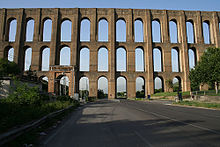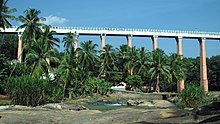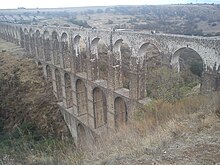
The Pont du Gard is an ancient Roman aqueduct bridge built in the first century AD to carry water over 50 km (31 mi) to the Roman colony of Nemausus (Nîmes). It crosses the river Gardon near the town of Vers-Pont-du-Gard in southern France. The Pont du Gard is one of the best preserved Roman aqueduct bridges. It was added to UNESCO's list of World Heritage sites in 1985 because of its exceptional preservation, historical importance, and architectural ingenuity.

Navigable aqueducts are bridge structures that carry navigable waterway canals over other rivers, valleys, railways or roads. They are primarily distinguished by their size, carrying a larger cross-section of water than most water-supply aqueducts. Roman aqueducts were used to transport water and were created in Ancient Rome. The 662-metre (2,172 ft) long steel Briare aqueduct carrying the Canal latéral à la Loire over the River Loire was built in 1896. It was ranked as the longest navigable aqueduct in the world for more than a century, until the Magdeburg Water Bridge in Germany took the title in the early 21st century.
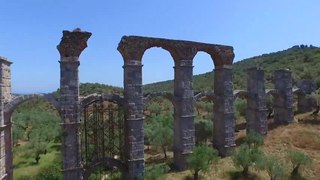
The Romans constructed aqueducts throughout their Republic and later Empire, to bring water from outside sources into cities and towns. Aqueduct water supplied public baths, latrines, fountains, and private households; it also supported mining operations, milling, farms, and gardens.

Aqua Anio Novus was an ancient Roman aqueduct supplying the city of Rome. Like the Aqua Claudia, it was begun by emperor Caligula in 38 AD and completed in 52 AD by Claudius, who dedicated them both on August 1.

Aqua Claudia was an ancient Roman aqueduct that, like the Aqua Anio Novus, was begun by Emperor Caligula in 38 AD and finished by Emperor Claudius in 52 AD.
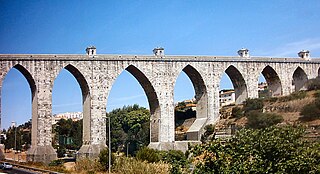
The Águas Livres Aqueduct is a historic aqueduct in the city of Lisbon, Portugal. It is one of the most remarkable examples of 18th-century Portuguese engineering. The main course of the aqueduct covers 18 km, but the whole network of canals reaches nearly 58 km.

The Aqueduct of Santa Clara is the second largest Portuguese aqueduct system. Built between 1626 and 1714, it includes 999 arches stretching for 4 kilometres (2.5 mi) from the spring of Terroso in the municipality of Póvoa de Varzim to the Convent of Santa Clara in the municipality of Vila do Conde.
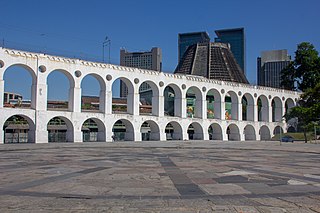
The Carioca Aqueduct, also known as Arcos da Lapa, is an aqueduct in the city of Rio de Janeiro, Brazil. The aqueduct was built in the middle of the 18th century to bring fresh water from the Carioca River to the population of the city. It is a typical example of colonial architecture and engineering.
De aquaeductu is a two-book official report given to the emperor Nerva or Trajan on the state of the aqueducts of Rome, and was written by Sextus Julius Frontinus at the end of the 1st century AD. It is also known as De Aquis or De Aqueductibus Urbis Romae. It is the earliest official report of an investigation made by a distinguished citizen on Roman engineering works to have survived. Frontinus had been appointed Water Commissioner by the emperor Nerva in AD 96.
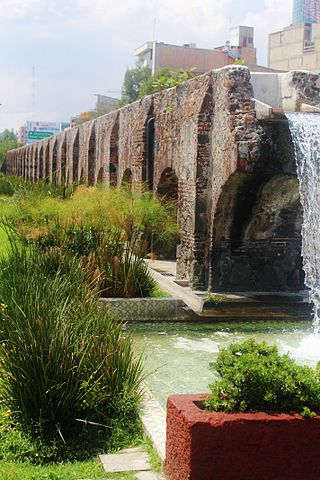
The Chapultepec aqueduct was built to provide potable water to Tenochtitlan, now known as Mexico City. Tenochtitlan was the capital of the Triple Aztec Alliance empire. This fresh water was transported from the Chapultepec springs. Two aqueducts following the same route from the springs were built by the Aztecs during the 15th century, the first destroyed by flooding and the second by the Spanish. After the Spanish conquest a colonial aqueduct was built, the ruins of which are located near Metro Sevilla.

The Pont de Bornègre is an ancient bridge of the Roman aqueduct to Nîmes, which also includes the famous Pont du Gard, between the communes of Saint-Maximin, and Argilliers. It is located at the upper reaches of the approximately 50 km long aqueduct, 6,745 m downstream of the Eure source and 9,061 m upstream of the Pont du Gard. The structure bridges an intermittent torrent, the Bordnègre, with a catchment area of 0.6–0.8 km2 and, according to modern estimates, a maximum flood flow of 5 m3/s water.

The Aqua Marcia is one of the longest of the eleven aqueducts that supplied the city of Rome. The aqueduct was built between 144–140 BC, during the Roman Republic. The still-functioning Acqua Felice from 1586 runs on long stretches along the route of the Aqua Marcia.

The Roman Dam of Belas is a 3rd-century Roman barrier constructed to serve the city of Olisipo, located in civil parish of Queluz e Belas, municipality of Sintra.
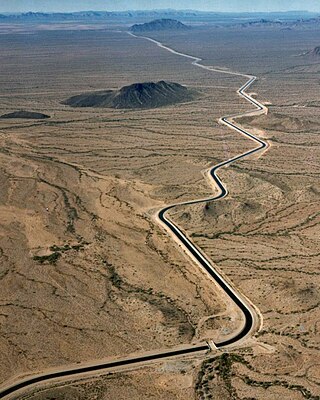
An aqueduct is a watercourse constructed to carry water from a source to a distribution point far away. In modern engineering, the term aqueduct is used for any system of pipes, ditches, canals, tunnels, and other structures used for this purpose. The term aqueduct also often refers specifically to a bridge carrying an artificial watercourse. Aqueducts were used in ancient Greece, ancient Near East, and ancient Rome. The simplest aqueducts are small ditches cut into the earth. Much larger channels may be used in modern aqueducts. Aqueducts sometimes run for some or all of their path through tunnels constructed underground. Modern aqueducts may also use pipelines. Historically, agricultural societies have constructed aqueducts to irrigate crops and supply large cities with drinking water.

The Aqua Anio Vetus was an ancient Roman aqueduct, and the second oldest after the Aqua Appia.

The Óbidos Aqueduct is a 16th-century aqueduct that spans the Portuguese municipality of Óbidos.

